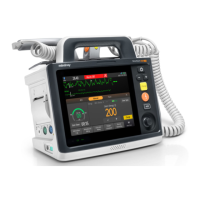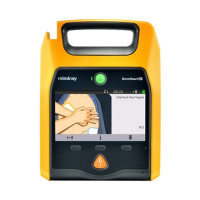11 - 1
11 Monitoring ECG
11.1 ECG Safety Information
• ECG monitoring provided by this equipment is not intended for direct cardiac application.
• Make sure the conductive parts of electrodes and associated connectors, including the neutral
electrode, do not contact any other conductive parts including earth.
• Use defibrillation-proof ECG cables during defibrillation.
• Do not touch the patient or metal devices connected to the patient during defibrillation.
• To reduce the hazard of burns during high-frequency surgical procedure, ensure that cables and
transducers connected to the equipment never come into contact with the electrosurgery unit (ESU).
• To reduce the hazard of burns during use of high-frequency surgical unit (ESU), the ECG electrodes
should not be located between the surgical site and the ESU return electrode.
• Periodically inspect the electrode application site to ensure skin integrity. If the skin quality
changes, replace the electrodes or change the application site.
• Interference from ungrounded instrument near the patient and electrosurgery interference can
induce noise and artifact into the waveforms.
• If selected lead cannot provide valid ECG signals, a dash line is shown in the ECG waveform area.
11.2 ECG Display
• The ECG numeric area and waveform area are configured to be different for different lead type and
ECG settings.
11.3 Preparing for ECG Monitoring
• The external paddles are not recommended for ECG monitoring.
11.3.1 Preparing the Patient for Electrode Application
• Proper skin preparation is necessary for good signal quality at the electrode site, as the skin is a poor
conductor of electricity.

